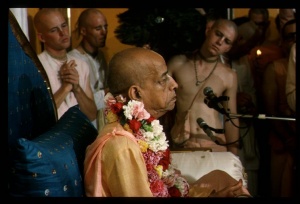CC Antya 3.223 (1975): Difference between revisions
(Vanibot #0027: CCMirror - Mirror CC's 1996 edition to form a basis for 1975) |
(Vanibot #0020: VersionCompareLinker - added a link to the Version Compare feature) |
||
| Line 2: | Line 2: | ||
<div style="float:left">'''[[Sri Caitanya-caritamrta (1975)|Śrī Caitanya-caritāmṛta (1975)]] - [[CC Antya (1975)|Antya-līlā]] - [[CC Antya 3 (1975)|Chapter 3: The Glories of Śrīla Haridāsa Ṭhākura]]'''</div> | <div style="float:left">'''[[Sri Caitanya-caritamrta (1975)|Śrī Caitanya-caritāmṛta (1975)]] - [[CC Antya (1975)|Antya-līlā]] - [[CC Antya 3 (1975)|Chapter 3: The Glories of Śrīla Haridāsa Ṭhākura]]'''</div> | ||
<div style="float:right">[[File:Go-previous.png|link=CC Antya 3.222 (1975)|Antya-līlā 3.222]] '''[[CC Antya 3.222 (1975)|Antya-līlā 3.222]] - [[CC Antya 3.224 (1975)|Antya-līlā 3.224]]''' [[File:Go-next.png|link=CC Antya 3.224 (1975)|Antya-līlā 3.224]]</div> | <div style="float:right">[[File:Go-previous.png|link=CC Antya 3.222 (1975)|Antya-līlā 3.222]] '''[[CC Antya 3.222 (1975)|Antya-līlā 3.222]] - [[CC Antya 3.224 (1975)|Antya-līlā 3.224]]''' [[File:Go-next.png|link=CC Antya 3.224 (1975)|Antya-līlā 3.224]]</div> | ||
{{CompareVersions|CC|Antya 3.223|CC 1975|CC 1996}} | |||
{{RandomImage}} | {{RandomImage}} | ||
==== TEXT 223 ==== | ==== TEXT 223 ==== | ||
<div class="verse"> | <div class="verse"> | ||
:jagat-nistāra | :jagat-nistāra lāgi' karena cintana | ||
:avaiṣṇava-jagat kemane ha-ibe mocana? | :avaiṣṇava-jagat kemane ha-ibe mocana? | ||
</div> | </div> | ||
| Line 18: | Line 17: | ||
<div class="synonyms"> | <div class="synonyms"> | ||
jagat-nistāra—the deliverance of the people of the whole world; | jagat-nistāra—the deliverance of the people of the whole world; lāgi'-for; karena cintana—was always thinking; avaiṣṇava—full of nondevotees; jagat—the whole world; kemane—how; ha-ibe mocana—will be delivered. | ||
</div> | </div> | ||
| Line 25: | Line 24: | ||
<div class="translation"> | <div class="translation"> | ||
Advaita Ācārya was always absorbed in thoughts of how to deliver the fallen souls of the entire world. | Advaita Ācārya was always absorbed in thoughts of how to deliver the fallen souls of the entire world. "The entire world is full of nondevotees," He thought. "How will they be delivered?" | ||
</div> | </div> | ||
| Line 32: | Line 31: | ||
<div class="purport"> | <div class="purport"> | ||
Śrīla Advaita Ācārya sets the standard for ācāryas in the Vaiṣṇava sampradāya. An ācārya must always be eager to deliver the fallen souls. A person who establishes a temple or maṭha to take advantage of | Śrīla Advaita Ācārya sets the standard for ācāryas in the Vaiṣṇava sampradāya. An ācārya must always be eager to deliver the fallen souls. A person who establishes a temple or maṭha to take advantage of people's sentiments by using for his livelihood what people contribute for the worship of the Deity cannot be called a gosvāmī or ācārya. One who knows the conclusion of the śāstras, follows in the footsteps of his predecessors and endeavors to preach the bhakti cult all over the world is to be considered an ācārya. The role of an ācārya is not to earn his livelihood through the income of the temple. Śrīla Bhaktisiddhānta Sarasvatī Ṭhākura used to say that if one earns his livelihood by displaying the Deity in the temple, he is not an ācārya or gosvāmī. it would be better for him to accept service even as a sweeper in the street, for that is a more honorable means of earning one's living. | ||
</div> | </div> | ||
Latest revision as of 01:18, 27 January 2020

A.C. Bhaktivedanta Swami Prabhupada
TEXT 223
- jagat-nistāra lāgi' karena cintana
- avaiṣṇava-jagat kemane ha-ibe mocana?
SYNONYMS
jagat-nistāra—the deliverance of the people of the whole world; lāgi'-for; karena cintana—was always thinking; avaiṣṇava—full of nondevotees; jagat—the whole world; kemane—how; ha-ibe mocana—will be delivered.
TRANSLATION
Advaita Ācārya was always absorbed in thoughts of how to deliver the fallen souls of the entire world. "The entire world is full of nondevotees," He thought. "How will they be delivered?"
PURPORT
Śrīla Advaita Ācārya sets the standard for ācāryas in the Vaiṣṇava sampradāya. An ācārya must always be eager to deliver the fallen souls. A person who establishes a temple or maṭha to take advantage of people's sentiments by using for his livelihood what people contribute for the worship of the Deity cannot be called a gosvāmī or ācārya. One who knows the conclusion of the śāstras, follows in the footsteps of his predecessors and endeavors to preach the bhakti cult all over the world is to be considered an ācārya. The role of an ācārya is not to earn his livelihood through the income of the temple. Śrīla Bhaktisiddhānta Sarasvatī Ṭhākura used to say that if one earns his livelihood by displaying the Deity in the temple, he is not an ācārya or gosvāmī. it would be better for him to accept service even as a sweeper in the street, for that is a more honorable means of earning one's living.